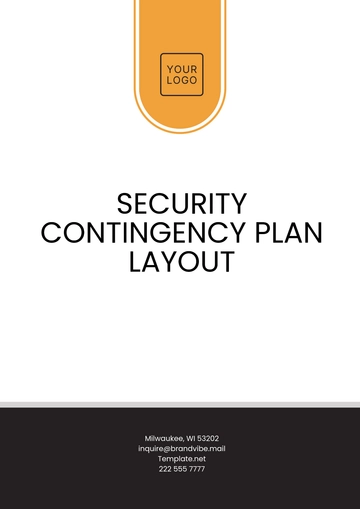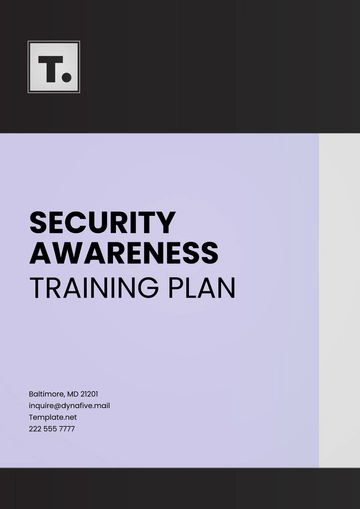Free Military Base Security Plan

I. Introduction
This Military Base Security Plan outlines comprehensive security protocols designed to safeguard a military installation. The primary goals are to prevent unauthorized access, protect critical assets, and ensure the safety of personnel and operations. This plan emphasizes a multi-layered defense strategy incorporating physical barriers, advanced technology, personnel training, and incident response protocols, ensuring readiness against evolving threats.
II. Security Objectives
Prevent Unauthorized Access: Maintain strict perimeter security to deter and prevent entry by unauthorized personnel or vehicles.
Protect personnel and assets: Ensure the safety of military personnel, equipment, and classified information from internal and external threats.
Detect, Deter, and Respond to Threats: Employ proactive threat detection methods and maintain rapid response capabilities to neutralize potential threats.
III. Security Measures
A. Perimeter Security
A well-fortified perimeter is the first line of defense. This section involves establishing strong physical barriers, continuous monitoring, and controlled entry points to prevent unauthorized access.
Perimeter Fencing: Install high-security fencing (e.g., electrified or anti-climb fences) with regular inspections for vulnerabilities.
Monitoring Systems: Deploy advanced CCTV systems with motion detection, night vision, and real-time alerts for suspicious activities.
Guard Posts: Position armed security personnel at all key entry points, checkpoints, and strategic locations around the base perimeter.
B. Access Control
Controlling access to the base ensures that only authorized personnel can enter or exit the facility.
Identification Systems: Implement biometric authentication, such as fingerprint or retinal scans, alongside ID badges with embedded RFID chips for secure entry.
Visitor Management: Establish strict protocols for visitors and contractors, including background checks, visitor badges, and escorted access to restricted areas.
C. Surveillance and Monitoring
A comprehensive surveillance and monitoring system ensures full visibility of base activities and rapid detection of unusual behaviors or threats.
Surveillance Cameras: Deploy 24/7 surveillance coverage in critical areas, including entry points, storage facilities, and command centers. Cameras should be capable of facial recognition and tracking.
Patrols: Conduct regular, randomized patrols using both foot patrols and vehicles, covering all base zones, including storage depots, armories, and communication towers.
D. Incident Response
Timely and effective response protocols are essential to mitigate damage during a security breach or emergency.
Emergency Procedures: Regularly update emergency response protocols, including lockdown procedures, evacuation plans, and active shooter drills. Perform periodic full-scale drills to assess readiness.
Communication Systems: Maintain encrypted communication channels, radios, and secure emergency notification systems to ensure uninterrupted communication during incidents.
IV. Personnel Training
Security is only as strong as the personnel executing it. Continuous training ensures preparedness and awareness.
Regular Security Drills: Conduct routine drills simulating a variety of scenarios, including breaches, espionage, and terrorist attacks.
Cyber Security Awareness: Train personnel on identifying and responding to cyber threats, phishing attacks, and the importance of safeguarding sensitive digital information.
Threat Identification Training: Equip security personnel with skills to identify suspicious behavior, unattended objects, or cyber anomalies quickly and effectively.
V. Technology Integration
Incorporating cutting-edge technology significantly enhances the base’s detection, defense, and response capabilities.
Technology | Purpose |
|---|---|
Drones | Perform aerial surveillance and monitor hard-to-reach areas, providing real-time intelligence. |
Biometrics | Enforce secure access control and verify identities at sensitive entry points. |
Thermal Cameras | Detect unauthorized movements during night operations and adverse weather conditions. |
AI-Powered Systems | Utilize AI for real-time monitoring, threat analysis, and automated alerts for suspicious activities. |
RFID & GPS Tracking | Track the movement of personnel, vehicles, and high-value equipment throughout the base. |
VI. Conclusion
This Military Base Security Plan serves as a foundational guide for securing all aspects of the installation. The integration of physical security measures, advanced technology, personnel training, and well-defined incident response protocols ensures a comprehensive defense strategy. Regular evaluation and adaptation of security procedures are necessary to address emerging threats, ensuring the continued safety and functionality of the military base.
- 100% Customizable, free editor
- Access 1 Million+ Templates, photo’s & graphics
- Download or share as a template
- Click and replace photos, graphics, text, backgrounds
- Resize, crop, AI write & more
- Access advanced editor
Enhance your military facility's safety with the Military Base Security Plan Template. This customizable and downloadable template is designed to streamline your security planning process. Printable and user-friendly, it allows you to tailor your strategies efficiently. Plus, it’s easily editable in our AI Editor Tool, ensuring your security measures meet evolving needs. Get peace of mind with this comprehensive solution, offered by Template.net.
You may also like
- Finance Plan
- Construction Plan
- Sales Plan
- Development Plan
- Career Plan
- Budget Plan
- HR Plan
- Education Plan
- Transition Plan
- Work Plan
- Training Plan
- Communication Plan
- Operation Plan
- Health And Safety Plan
- Strategy Plan
- Professional Development Plan
- Advertising Plan
- Risk Management Plan
- Restaurant Plan
- School Plan
- Nursing Home Patient Care Plan
- Nursing Care Plan
- Plan Event
- Startup Plan
- Social Media Plan
- Staffing Plan
- Annual Plan
- Content Plan
- Payment Plan
- Implementation Plan
- Hotel Plan
- Workout Plan
- Accounting Plan
- Campaign Plan
- Essay Plan
- 30 60 90 Day Plan
- Research Plan
- Recruitment Plan
- 90 Day Plan
- Quarterly Plan
- Emergency Plan
- 5 Year Plan
- Gym Plan
- Personal Plan
- IT and Software Plan
- Treatment Plan
- Real Estate Plan
- Law Firm Plan
- Healthcare Plan
- Improvement Plan
- Media Plan
- 5 Year Business Plan
- Learning Plan
- Marketing Campaign Plan
- Travel Agency Plan
- Cleaning Services Plan
- Interior Design Plan
- Performance Plan
- PR Plan
- Birth Plan
- Life Plan
- SEO Plan
- Disaster Recovery Plan
- Continuity Plan
- Launch Plan
- Legal Plan
- Behavior Plan
- Performance Improvement Plan
- Salon Plan
- Security Plan
- Security Management Plan
- Employee Development Plan
- Quality Plan
- Service Improvement Plan
- Growth Plan
- Incident Response Plan
- Basketball Plan
- Emergency Action Plan
- Product Launch Plan
- Spa Plan
- Employee Training Plan
- Data Analysis Plan
- Employee Action Plan
- Territory Plan
- Audit Plan
- Classroom Plan
- Activity Plan
- Parenting Plan
- Care Plan
- Project Execution Plan
- Exercise Plan
- Internship Plan
- Software Development Plan
- Continuous Improvement Plan
- Leave Plan
- 90 Day Sales Plan
- Advertising Agency Plan
- Employee Transition Plan
- Smart Action Plan
- Workplace Safety Plan
- Behavior Change Plan
- Contingency Plan
- Continuity of Operations Plan
- Health Plan
- Quality Control Plan
- Self Plan
- Sports Development Plan
- Change Management Plan
- Ecommerce Plan
- Personal Financial Plan
- Process Improvement Plan
- 30-60-90 Day Sales Plan
- Crisis Management Plan
- Engagement Plan
- Execution Plan
- Pandemic Plan
- Quality Assurance Plan
- Service Continuity Plan
- Agile Project Plan
- Fundraising Plan
- Job Transition Plan
- Asset Maintenance Plan
- Maintenance Plan
- Software Test Plan
- Staff Training and Development Plan
- 3 Year Plan
- Brand Activation Plan
- Release Plan
- Resource Plan
- Risk Mitigation Plan
- Teacher Plan
- 30 60 90 Day Plan for New Manager
- Food Safety Plan
- Food Truck Plan
- Hiring Plan
- Quality Management Plan
- Wellness Plan
- Behavior Intervention Plan
- Bonus Plan
- Investment Plan
- Maternity Leave Plan
- Pandemic Response Plan
- Succession Planning
- Coaching Plan
- Configuration Management Plan
- Remote Work Plan
- Self Care Plan
- Teaching Plan
- 100-Day Plan
- HACCP Plan
- Student Plan
- Sustainability Plan
- 30 60 90 Day Plan for Interview
- Access Plan
- Site Specific Safety Plan





























